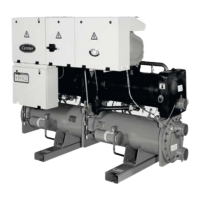9
2.2.1 - Moving
See chapter 1.1 “Installation safety considerations”.
CAUTION: Only use slings at the designated lifting points which
are marked on the unit.
2.2.2 - Siting the unit
Always refer to the chapter “Dimensions and clearances” to
conrm that there is adequate space for all connections and service
operations. For the centre of gravity coordinates, the position of
the unit mounting holes, and the weight distribution points, refer
to the certied dimensional drawing supplied with the unit.
Typical applications of these units are in refrigeration systems,
and they do not require earthquake resistance. Earthquake
resistance has not been veried.
Before siting the unit check that:
• the permitted loading at the site is adequate or that appropriate
strenghtening measures have been taken.
• the unit is installed level on an even surface (maximum
tolerance is 5 mm in both axes).
• there is adequate space above the unit for air ow and to
ensure access to the components.
• the number of support points is adequate and that they are
in the right places.
• the location is not subject to ooding.
CAUTION: Lift and set down the unit with great care. Tilting
and jarring can damage the unit and impair unit operation.
2.2.3 - Checks before system start-up
Before the start-up of the refrigeration system, the complete
installation, including the refrigeration system must be veried
against the installation drawings, dimensional drawings, system
piping and instrumentation diagrams and the wiring diagrams.
During the installation test national regulations must be followed.
If no national regulation exists, standard EN 378 can be used as
a guide.
• External visual installation checks:
• Ensure that the machine is charged with refrigerant. Verify
on the unit nameplate that the ‘uid being transported’ is
R-134a and is not nitrogen.
• Compare the complete installation with the refrigeration
system and power circuit diagrams.
• Check that all components comply with the design
specications.
• Check that all protection documents and equipment provided
by the manufacturer (dimensional drawings, P&ID,
declarations etc.) to comply with the regulations are present.
• Verify that the environmental safety and protection and
devices and arrangements provided by the manufacturer to
comply with the regulations are in place.
• Verify that all document for pressure containers, certicates,
name plates, les, instruction manuals provided by the
manufacturer to comply with the regulations are present.
• Verify the free passage of access and safety routes.
• Check that ventilation in the plant room is adequate.
• Check that refrigerant detectors are present.
• Verify the instructions and directives to prevent the deliberate
removal of refrigerant gases that are harmful to the
environment.
• Verify the installation of connections.
• Verify the supports and xing elements (materials, routing
and connection).
• Verify the quality of welds and other joints.
• Check the protection against mechanical damage.
• Check the protection against heat.
• Check the protection of moving parts.
• Verify the accessibility for maintenance or repair and to
check the piping.
• Verify the status of the valves.
• Verify the quality of the thermal insulation and of the vapour
barriers.

